
In biology, a common name of a taxon or organism is a name that is based on the normal language of everyday life; and is often contrasted with the scientific name for the same organism, which is often based in Latin. A common name is sometimes frequently used, but that is not always the case.

Pseudemys is a genus of large, herbivorous, freshwater turtles of the eastern United States and adjacent northeast Mexico. They are often referred to as cooters, which stems from kuta, the word for turtle in the Bambara and Malinké languages, brought to America by enslaved people from Africa.

The American toad is a common species of toad found throughout Canada and the eastern United States. It is divided into three subspecies: the eastern American toad, the dwarf American toad and the rare Hudson Bay toad. Recent taxonomic treatments place this species in the genus Anaxyrus instead of Bufo.

Pituophis catenifer is a species of nonvenomous colubrid snake endemic to North America. Nine subspecies are currently recognized, including the nominotypical subspecies, Pituophis catenifer catenifer, described here. This snake is often mistaken for the prairie rattlesnake, but can be easily distinguished from a rattlesnake by the lack of black and white banding on its tail and by the shape of its head, which is narrower than a rattlesnake's.
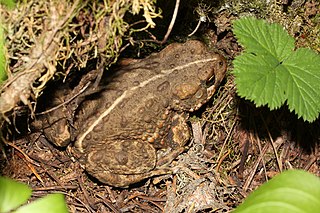
The western toad is a large toad species, between 5.6 and 13 cm long, native to western North America. A. boreas is frequently encountered during the wet season on roads, or near water at other times. It can jump a considerable distance for a toad. Breeding occurs between March and July in mountainous areas, and as early as January in lower-elevation regions. The female lays up to 17,000 eggs stuck together in strings that adhere to vegetation and other objects along water edges.

The western cottonmouth was once classified as a subspecies of the cottonmouth. However, DNA based studies published in 2008 and 2015, revealed no significant genetic difference between the eastern cottonmouth and the western cottonmouth and synonymized the two subspecies. The resulting taxonomy does not recognizes the western cottonmouth as a valid taxon. Several subsequent reviews and species accounts have followed and supported the revised taxonomy. Information on this snake can be found in the Agkistrodon piscivorus article.

The northern sheep frog is native to Central America, Mexico, and extreme south Texas, United States. It occurs in the lowlands from Sonora, Mexico, to northern Costa Rica on the Pacific coast, and south Texas to Honduras on the Gulf of Mexico and Caribbean coasts. The sheep frog inhabits semiarid thornscrub, savannas, pasturelands, and open woodlands, as well as more humid, moist forest in the canyons, basins, foothills, and lower elevations of mountains slopes. It is a fossorial, burrowing frog that is seldom seen on the surface except at night after heavy rains when they emerge to breed. The sheep frog gets its name from its distinctive call that resembles a sheep's bleat. It is a diet specialist primarily feeding on termites and ants.
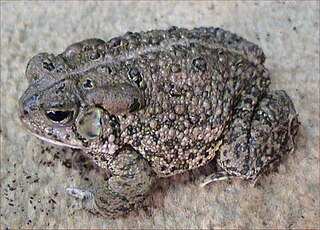
Woodhouse's toad is a medium-sized true toad native to the United States and Mexico. There are three recognized subspecies. A. woodhousii tends to hybridize with Anaxyrus americanus where their ranges overlap.
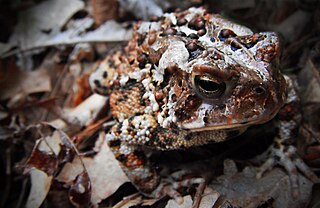
Fowler's toad is a species of toad in the family Bufonidae. The species is native to North America, where it occurs in much of the eastern United States and parts of adjacent Canada. It was previously considered a subspecies of Woodhouse's toad.

The Canadian toad, also known commonly as the Dakota toad, is a species of toad that ranges from the prairie regions of western Canada south to parts of the upper midwest of the United States. It belongs to the family Bufonidae, the "true" toads. Its specific name is derived from the Latin word hemiophrys, meaning eyebrow, which refers to its pronounced cranial crest between and behind the eyes. Anaxyrus hemiophrys displays the typical toad characteristics: it lacks a tail and teeth, it has a horizontal pupil, and its dry skin is thick and warty.
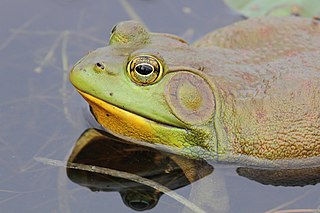
Lithobates is a genus of true frogs, of the family Ranidae. The name is derived from litho- (stone) and the Greek bates, meaning one that treads on rock, or rock climber.
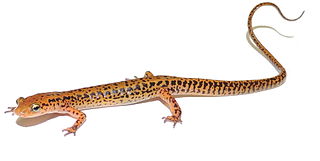
Eurycea longicauda, commonly known as the long-tailed salamander or longtail salamander, is a species of lungless salamander native to the Appalachian Region of the eastern United States. It is a "cave salamander" that frequents twilight zones of caves and also inhabits springs and surrounding forest.

Agkistrodon contortrix mokasen was formerly a venomous pit viper subspecies found in the eastern United States. However, recent taxonomic changes do not recognize the northern copperhead as a valid taxon.
Joseph Thomas Collins, Jr. was an American herpetologist. A graduate of the University of Cincinnati, Collins authored 27 books and over 300 articles on wildlife, of which about 250 were on amphibians and reptiles. He was the founder of the Center for North American Herpetology (CNAH). He died while studying amphibians and reptiles on St. George Island, Florida on 14 January 2012. "For 60 years I was obsessed with herpetology," Joe Collins claimed.












